Chief Justice of the United States
| Chief Justice of the United States | |
|---|---|
 | |
since September 29, 2005 | |
| Style | The Honorable (formal) Mr. Chief Justice (informal) Your Honor (when addressed directly in court) |
| Appointer | Presidential nomination with Senate confirmation |
| Term length | Life tenure |
| Inaugural holder | John Jay as Chief Justice of the Supreme Court September 26, 1789 |
| Formation | U.S. Constitution March 4, 1789 |
| This article is part of a series on the |
| Politics of the United States |
|---|
 |
The Chief Justice of the United States is the head of the United States federal court system (the judicial branch of the federal government of the United States) and the chief judge of the Supreme Court of the United States. The Chief Justice is one of nine Supreme Court justices; the other eight are the Associate Justices of the Supreme Court of the United States. From 1789 until 1866, the office was known as the Chief Justice of the Supreme Court.
The Chief Justice is the highest judicial officer in the country, and acts as a chief administrative officer for the federal courts and, as head of the Judicial Conference of the United States, appoints the director of the Administrative Office of the United States Courts. The Chief Justice also serves as a spokesperson for the judicial branch.
The Chief Justice leads the business of the Supreme Court and presides over oral arguments. When the court renders an opinion, the Chief Justice—when in the majority—decides who writes the court's opinion. The Chief Justice also has significant agenda-setting power over the court's meetings. In the case of an impeachment of a President of the United States, which has occurred twice, the Chief Justice presides over the trial in the Senate. In modern tradition, the Chief Justice also has the ceremonial duty of administering the oath of office of the President of the United States.
The first Chief Justice was John Jay. The 17th and current Chief Justice is John G. Roberts, Jr.
Origin, title, and appointment to the post

The United States Constitution does not explicitly establish the office of Chief Justice, but presupposes its existence with a single reference in Article I, Section 3, Clause 6: "When the President of the United States is tried, the Chief Justice shall preside." Nothing more is said in the Constitution regarding the office, including any distinction between the Chief Justice and Associate Justices of the Supreme Court, who are not mentioned in the Constitution.
The office was originally known as "Chief Justice of the Supreme Court" and is still informally referred to using that title. However, 28 U.S.C. § 1 specifies that the title is "Chief Justice of the United States". The title was changed from Chief Justice of the Supreme Court by Congress in 1866 at the suggestion of the sixth Chief Justice, Salmon P. Chase.[1] Chase wished to emphasize the Supreme Court's role as a co-equal branch of government. The first Chief Justice commissioned using the new title was Melville Fuller in 1888.[1] Use of the previous title when referring to Chief Justices John Jay through Roger B. Taney is technically correct, as that was the legal title during their time on the court, but the newer title is frequently used retroactively for all Chief Justices.
The other eight members of the court are officially Associate Justices of the Supreme Court of the United States, not "Associate Justices of the United States." The Chief Justice is the only member of the court to whom the Constitution refers as a "Justice," and only in Article I. Article III of the Constitution refers to all members of the Supreme Court (and of other federal courts) simply as "Judges."
The Chief Justice is nominated by the President of the United States and confirmed to sit on the Court by the United States Senate. The U.S. Constitution states that all justices of the court "shall hold their offices during good behavior," meaning that the appointments end only when a justice dies in office, resigns, or is impeached by the United States House of Representatives and convicted at trial by the Senate. The salary of the Chief Justice is set by Congress; the Constitution prohibits Congress from lowering the salary of any judge, including the Chief Justice, while that judge holds office. As of 2015[update], the salary is $258,100 per year, which is slightly higher than that of the Associate Justices, which is $246,800.[2]
While the Chief Justice is appointed by the President, there is no specific constitutional prohibition against using another method to select the Chief Justice from among those Justices properly appointed and confirmed to the Supreme Court, and at least one scholar has proposed that presidential appointment should be done away with, and replaced by a process that permits the Justices to select their own Chief Justice.[3]
Three serving Associate Justices have received promotions to Chief Justice: Edward Douglass White in 1910, Harlan Fiske Stone in 1941, and William Rehnquist in 1986. Associate Justice Abe Fortas was nominated to the position of Chief Justice of the United States, but his nomination was filibustered by Senate Republicans in 1968. Despite the failed nomination, Fortas remained an Associate Justice until his resignation the following year. Most Chief Justices, including John Roberts, have been nominated to the highest position on the Court without any previous experience on the Supreme Court; indeed some, such as Earl Warren, received confirmation despite having no prior judicial experience.
There have been 21 individuals nominated for Chief Justice, of whom 17 have been confirmed by the Senate, although a different 17 have served. The second Chief Justice, John Rutledge, served in 1795 on a recess appointment, but did not receive Senate confirmation. Associate Justice William Cushing received nomination and confirmation as Chief Justice in January 1796, but declined the office; President Washington then nominated, and the Senate confirmed, Oliver Ellsworth, who served instead. The Senate subsequently confirmed President Adams's nomination of John Jay to replace Ellsworth, but Jay declined to resume his former office, citing the burden of riding circuit and its impact on his health, and his perception of the Court's lack of prestige. Adams then nominated John Marshall, whom the Senate confirmed shortly afterward.
When the Chief Justice dies in office or is otherwise unwilling or unable to serve, the duties of the Chief Justice are performed temporarily by the most senior sitting associate justice, who acts as Chief Justice until a new Chief Justice is confirmed.[3][4] As of February 13, 2016, Anthony Kennedy is the most senior associate justice.
Duties
Along with the duties of the associate justices, the Chief Justice has several unique duties.
Impeachment trials
Article I, section 3 of the U.S. Constitution stipulates that the Chief Justice shall preside over impeachment trials of the President of the United States in the U.S. Senate. Two Chief Justices, Salmon P. Chase and William Rehnquist, have presided over the trial in the Senate that follows an impeachment of the president – Chase in 1868 over the proceedings against President Andrew Johnson and Rehnquist in 1999 over the proceedings against President Bill Clinton. Both presidents were subsequently acquitted.
Seniority
Many of the procedures and inner workings of the Court turn on the seniority of the justices. Traditionally, the Chief Justice has been regarded as primus inter pares (first among equals)—that is, the Chief Justice is the highest-ranking and foremost member of the Court, regardless of that officeholder's length of service when compared against that of any associate justice. The Chief Justice sets the agenda for the weekly meetings where the justices review the petitions for certiorari, to decide whether to hear or deny each case. The Supreme Court agrees to hear less than one percent of the cases petitioned to it. While associate justices may append items to the weekly agenda, in practice this initial agenda-setting power of the Chief Justice has significant influence over the direction of the court. Additionally, the Chief Justice chairs the conferences where cases are discussed and tentatively voted on by the justices. The Chief Justice normally speaks first and so has influence in framing the discussion.

Despite the seniority and added prestige, the Chief Justice's vote carries the same legal weight as each of the other eight justices. In any decision, he has no legal authority to overrule the verdicts or interpretations of the other eight judges or tamper with them. The task of assigning who shall write the opinion for the majority falls to the most senior justice in the majority. Thus, when the Chief Justice is in the majority, he always assigns the opinion.[5] Early in his tenure, Chief Justice John Marshall insisted upon holdings which the justices could unanimously back as a means to establish and build the Court's national prestige. In doing so, Marshall would often write the opinions himself, and actively discouraged dissenting opinions. Associate Justice William Johnson eventually persuaded Marshall and the rest of the Court to adopt its present practice: one justice writes an opinion for the majority, and the rest are free to write their own separate opinions or not, whether concurring or dissenting.[6]
However, the power to determine the opinion author (including the option to select oneself) allows a Chief Justice in the majority to influence the historical record. Two justices in the same majority, given the opportunity, might write very different majority opinions (as evidenced by many concurring opinions); being assigned the opinion may also cement the vote of an associate who is viewed as only marginally in the majority (a tactic that was reportedly used to some effect by Earl Warren). A Chief Justice who knows well the associate justices can therefore do much—by the simple act of selecting the justice who writes the opinion of the court—to affect the "flavor" of the opinion, which in turn can affect the interpretation of that opinion in cases before lower courts in the years to come. It is reported that Warren E. Burger sometimes switched votes to a majority he disagreed with in order to use this prerogative of the Chief Justice to dictate who would write the opinion.[7]
Oath of office
The Chief Justice typically administers the oath of office at the inauguration of the President of the United States. This is a tradition, rather than a constitutional responsibility of the Chief Justice; the Constitution does not require that the oath be administered by anyone in particular, simply that it be taken by the president. Law empowers any federal and state judge, as well as notaries public, to administer oaths and affirmations.

If the Chief Justice is ill or incapacitated, the oath is usually administered by the next senior member of the Supreme Court. Seven times, someone other than the Chief Justice of the United States administered the oath of office to the President.[8] Robert Livingston, as Chancellor of the State of New York (the state's highest ranking judicial office), administered the oath of office to George Washington at his first inauguration; there was no Chief Justice of the United States, nor any other federal judge prior to their appointments by President Washington in the months following his inauguration. William Cushing, an associate justice of the Supreme Court, administered Washington's second oath of office in 1793. Calvin Coolidge's father, a notary public, administered the oath to his son after the death of Warren Harding.[9] This, however, was contested upon Coolidge's return to Washington and his oath was re-administered by Judge Adolph A. Hoehling, Jr. of the U.S. District Court for the District of Columbia.[10] John Tyler and Millard Fillmore were both sworn in on the death of their predecessors by Chief Justice William Cranch of the Circuit Court of the District of Columbia.[11] Chester A. Arthur and Theodore Roosevelt's initial oaths reflected the unexpected nature of their taking office. On November 22, 1963, after the assassination of President John F. Kennedy, Judge Sarah T. Hughes, a federal district court judge of the United States District Court for the Northern District of Texas, administered the oath of office to then Vice President Lyndon B. Johnson aboard the presidential airplane.
In addition, the Chief Justice ordinarily administers the oath of office to newly appointed and confirmed associate justices, whereas the senior associate justice will normally swear in a new Chief Justice or vice president.
Other duties
Since the tenure of William Howard Taft, the office of the Chief Justice has moved beyond just first among equals.[12] The Chief Justice also:
- Serves as the head of the federal judiciary.
- Serves as the head of the Judicial Conference of the United States, the chief administrative body of the United States federal courts. The Judicial Conference is empowered by the Rules Enabling Act to propose rules, which are then promulgated by the Supreme Court (subject to disapproval by Congress), to ensure the smooth operation of the federal courts. Major portions of the Federal Rules of Civil Procedure and Federal Rules of Evidence have been adopted by most state legislatures and are considered canonical by American law schools.
- Appoints sitting federal judges to the membership of the United States Foreign Intelligence Surveillance Court (FISC), a "secret court" which oversees requests for surveillance warrants by federal police agencies (primarily the F.B.I.) against suspected foreign intelligence agents inside the United States. (see 50 U.S.C. § 1803).
- Appoints the members of the Judicial Panel on Multidistrict Litigation, a special tribunal of seven sitting federal judges responsible for selecting the venue for coordinated pretrial proceedings in situations where multiple related federal actions have been filed in different judicial districts.
- Serves ex officio as a member of the Board of Regents, and by custom as the Chancellor, of the Smithsonian Institution.
- Supervises the acquisition of books for the Law Library of the Library of Congress.[13]
Unlike Senators and Representatives who are constitutionally prohibited from holding any other "office of trust or profit" of the United States or of any state while holding their congressional seats, the Chief Justice and the other members of the federal judiciary are not barred from serving in other positions. Chief Justice John Jay served as a diplomat to negotiate the so-called Jay Treaty (also known as the Treaty of London of 1794), and Chief Justice Earl Warren chaired The President's Commission on the Assassination of President Kennedy. As described above, the Chief Justice holds office in the Smithsonian Institution and the Library of Congress.
Disability or vacancy
Under 28 USC,[14] when the Chief Justice is unable to discharge his functions, or that office is vacant, his duties are carried out by the most senior associate justice who is able to act, until the disability or vacancy ends.
List of Chief Justices
| № | Chief Justice | Appointment | Term of office | Length of service | Retirement | Prior experience | Nominator | |
|---|---|---|---|---|---|---|---|---|
| 1 | 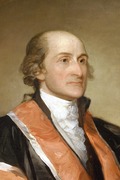
|
John Jay December 12, 1745 - May 17, 1829 (aged 83) |
September 24, 1789 Confirmation: September 26, 1789 |
September 26, 1789 – June 29, 1795 |
5 years, 276 days | 33 years, 322 days | U.S. Secretary of Foreign Affairs U.S. Minister to Spain President of the Continental Congress |
Washington |
| 2 | File:John Rutledge.jpg | John Rutledge September 17, 1739 - July 23, 1800 (aged 60) |
June 30, 1795 Confirmation: December 15, 1795 Recess appointment rejected |
June 30, 1795 – December 28, 1795 |
181 days | 4 years, 207 days | Fmr. Associate Justice of the Supreme Court 1st Governor of South Carolina | |
| 3 | 
|
Oliver Ellsworth April 29, 1745 - November 26, 1807 (aged 62) |
March 3, 1796 Confirmation: March 4, 1796 |
March 8, 1796 – December 15, 1800 |
4 years, 282 days | 6 years, 346 days | U.S. Senator from Connecticut | |
| 4 | 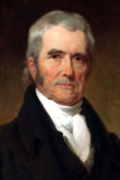
|
John Marshall September 24, 1755 - July 6, 1835 (aged 79) |
January 20, 1801 Confirmation: January 27, 1801 |
February 4, 1801 – July 6, 1835 |
34 years, 152 days | † | 4th U.S. Secretary of State U.S. Representative for Virginia's 13th
|
J. Adams (F) |
| 5 | 
|
Roger B. Taney March 17, 1777 - October 12, 1864 (aged 87) |
December 28, 1835 Confirmation: March 15, 1836 |
March 28, 1836 – October 12, 1864 |
28 years, 198 days | † | 12th U. S. Secretary of the Treasury 11th U.S. Attorney General 10th Attorney General of Maryland |
Jackson (D) |
| 6 | 
|
Salmon P. Chase January 13, 1808 - May 7, 1873 (aged 65) |
December 6, 1864 Confirmation: December 6, 1864 |
December 15, 1864 – May 7, 1873 |
8 years, 152 days | † | 25th U.S. Secretary of the Treasury 23rd Governor of Ohio U.S. Senator from Ohio |
Lincoln (R) |
| 7 | 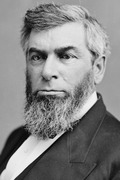
|
Morrison Waite November 29, 1816 - March 23, 1888 (aged 71) |
January 19, 1874 Confirmation: January 21, 1874 |
March 4, 1874 – March 23, 1888 |
14 years, 19 days | † | Ohio State Senator | Grant (R) |
| 8 | 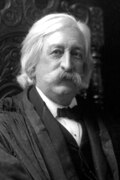
|
Melville Fuller February 11, 1833 - July 4, 1910 (aged 77) |
April 30, 1888 Confirmation: July 20, 1888 |
October 8, 1888 – July 4, 1910 |
21 years, 269 days | † | President of the Illinois State Bar Association Illinois State Representative |
Cleveland (D) |
| 9 | 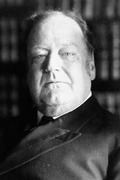
|
Edward Douglass White November 3, 1845 - May 19, 1921 (aged 75) |
December 12, 1910 Confirmation: December 12, 1910 |
December 19, 1910 – May 19, 1921 |
10 years, 151 days | † | Associate Justice of the Supreme Court U.S. Senator from Louisiana Associate Justice of the Louisiana Supreme Court |
Taft (R) |
| 10 | 
|
William Howard Taft September 15, 1857 - March 8, 1930 (aged 72) |
June 30, 1921 Confirmation: June 30, 1921 |
July 11, 1921 – February 3, 1930 |
8 years, 207 days | 33 days | 27th President of the United States 42nd U.S. Secretary of War Governor-General of the Philippines Judge of the U.S. Court of Appeals for the Sixth Circuit 6th Solicitor General of the United States |
Harding (R) |
| 11 | 
|
Charles Evans Hughes April 11, 1862 - August 27, 1948 (aged 86) |
February 3, 1930 Confirmation: February 13, 1930 |
February 24, 1930 – July 1, 1941 |
11 years, 126 days | 7 years, 58 days | 44th U.S. Secretary of State Fmr. Associate Justice of the Supreme Court 36th Governor of New York |
Hoover (R) |
| 12 | 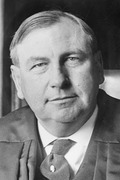
|
Harlan F. Stone October 11, 1872 - April 22, 1946 (aged 73) |
June 12, 1941 Confirmation: June 27, 1941 |
July 3, 1941 – April 22, 1946 |
4 years, 293 days | † | Associate Justice of the Supreme Court 52nd U.S. Attorney General Dean of Columbia Law School |
F. D. Roosevelt (D) |
| 13 | 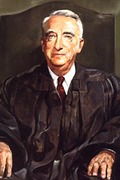
|
Fred M. Vinson January 22, 1890 - September 8, 1953 (aged 63) |
June 6, 1946 Confirmation: June 20, 1946 |
June 24, 1946 – September 8, 1953 |
7 years, 76 days | † | 53rd U.S. Secretary of the Treasury Director of the Office of Economic Stabilization Judge of the U. S. Court of Appeals for the District of Columbia Circuit U.S. Representative for Kentucky's 8th and 9th |
Truman (D) |
| 14 | 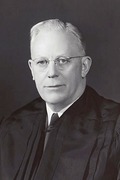
|
Earl Warren March 19, 1891 - July 9, 1974 (aged 83) |
January 11, 1954 Confirmation: March 1, 1954 |
October 5, 1953[15] – June 23, 1969 |
15 years, 261 days | 5 years, 16 days | 30th Governor of California 20th Attorney General of California |
Eisenhower (R) |
| 15 | 
|
Warren E. Burger September 17, 1907 - June 25, 1995 (aged 87) |
May 21, 1969 Confirmation: June 9, 1969 |
June 23, 1969 – September 26, 1986 |
17 years, 95 days | 8 years, 272 days | Judge of the U.S. Court of Appeals for the District of Columbia Circuit U.S. Asst. Attorney General for the Civil Division |
Nixon (R) |
| 16 | 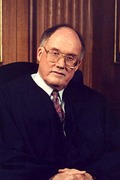
|
William Rehnquist October 1, 1924 - September 3, 2005 (aged 80) |
June 17, 1986 Confirmation: September 17, 1986 |
September 26, 1986 – September 3, 2005 |
18 years, 342 days | † | Associate Justice of the Supreme Court U.S. Asst. Attorney General for Legal Counsel |
Reagan (R) |
| 17 | 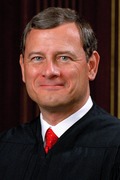
|
John Roberts Born: January 27, 1955 |
September 6, 2005 Confirmation: September 29, 2005 |
September 29, 2005 – present |
19 years, 34 days | Incumbent | Judge of the U.S. Court of Appeals for the District of Columbia Circuit | G. W. Bush (R) |
- Indicates incumbent
- Teal text indicates a recess appointment
- ¤ Previously served as an Associate Justice, but at a time disconnected to service as Chief Justice
- ° Elevated from Associate Justice
- † Died in office
- Bold text indicates the longest length of service
Data based on:
- The Oxford Guide to United States Supreme Court Decisions, Kermit L. Hall, 1999, Oxford University Press
- Supreme Court Nominations, present-1789[16]
- Members of the Supreme Court of the United States[17]
See also
Notes and references
- ^ a b "History of the Federal Judiciary". Fjc.gov. Retrieved 2011-08-17.
- ^ "Judicial Compensation | United States Courts". Uscourts.gov. Retrieved 2015-06-21.
- ^ a b Pettys, Todd E. (2006). "Choosing a Chief Justice: Presidential Prerogative or a Job for the Court?". Journal of Law & Politics. 22: 231.
- ^ 28 U.S.C. §§3-4.
- ^ O'Brien, David M. (2008). Storm Center: The Supreme Court in American Politics (8th ed.). New York: W. W. Norton. p. 267. ISBN 978-0-393-93218-8.
- ^ O'Brien, David M. (2008). Storm Center: The Supreme Court in American Politics (8th ed.). New York: W. W. Norton. p. 115. ISBN 978-0-393-93218-8.
- ^ See for example the description of the behind-the-scenes maneuvering after Roe v. Wade was argued the first time, in Bob Woodward and Scott Armstrong's The Brethren.
- ^ "Presidential Inaugurations: Presidential Oaths of Office". Memory.loc.gov. Retrieved 2015-06-21.
- ^ "Excerpt from Coolidge's autobiography". Historicvermont.org. Retrieved 2010-05-15.
- ^ "Prologue: Selected Articles". Archives.gov. Retrieved 2010-05-15.
- ^ "Presidential Swearing-In Ceremony, Part 5 of 6". Inaugural.senate.gov. Retrieved 2011-08-17.
- ^ O'Brien, David M. (2008). Storm Center: The Supreme Court in American Politics (8th ed.). New York: W. W. Norton. p. 153. ISBN 978-0-393-93218-8.
- ^ "Jefferson's Legacy: A Brief History of the Library of Congress". Library of Congress. 2006-03-06. Retrieved 2008-01-14.
- ^ "28 U.S. Code § 3 - Vacancy in office of Chief Justice; disability | LII / Legal Information Institute". Law.cornell.edu. Retrieved 2015-06-21.
- ^ Warren was placed on the Court by recess appointment; he was formally nominated and confirmed afterwards, and was sworn in on March 2, 1954
- ^ United States Senate, Supreme Court Nominations, present-1789
- ^ "Members of the Supreme Court of the United States - Text Version". Supremecourt.gov. Retrieved 2015-06-21.
Further reading
- Abraham, Henry J. (1992). Justices and Presidents: A Political History of Appointments to the Supreme Court (3rd ed.). New York: Oxford University Press. ISBN 0-19-506557-3.
- Cushman, Clare (2001). The Supreme Court Justices: Illustrated Biographies, 1789–1995 (2nd ed.). (Supreme Court Historical Society, Congressional Quarterly Books). ISBN 1-56802-126-7.
- Flanders, Henry. The Lives and Times of the Chief Justices of the United States Supreme Court. Philadelphia: J. B. Lippincott & Co., 1874 at Google Books.
- Frank, John P. (1995). Friedman, Leon; Israel, Fred L. (eds.). The Justices of the United States Supreme Court: Their Lives and Major Opinions. Chelsea House Publishers. ISBN 0-7910-1377-4.
- Hall, Kermit L., ed. (1992). The Oxford Companion to the Supreme Court of the United States. New York: Oxford University Press. ISBN 0-19-505835-6.
- Martin, Fenton S.; Goehlert, Robert U. (1990). The U.S. Supreme Court: A Bibliography. Washington, D.C.: Congressional Quarterly Books. ISBN 0-87187-554-3.
- Urofsky, Melvin I. (1994). The Supreme Court Justices: A Biographical Dictionary. New York: Garland Publishing. p. 590. ISBN 0-8153-1176-1.
External links
 Media related to Chief Justice of the United States at Wikimedia Commons
Media related to Chief Justice of the United States at Wikimedia Commons



